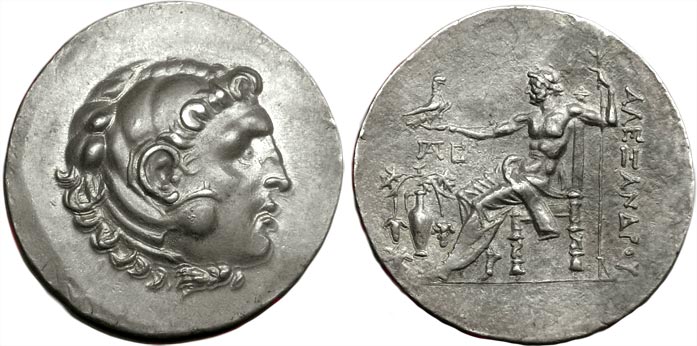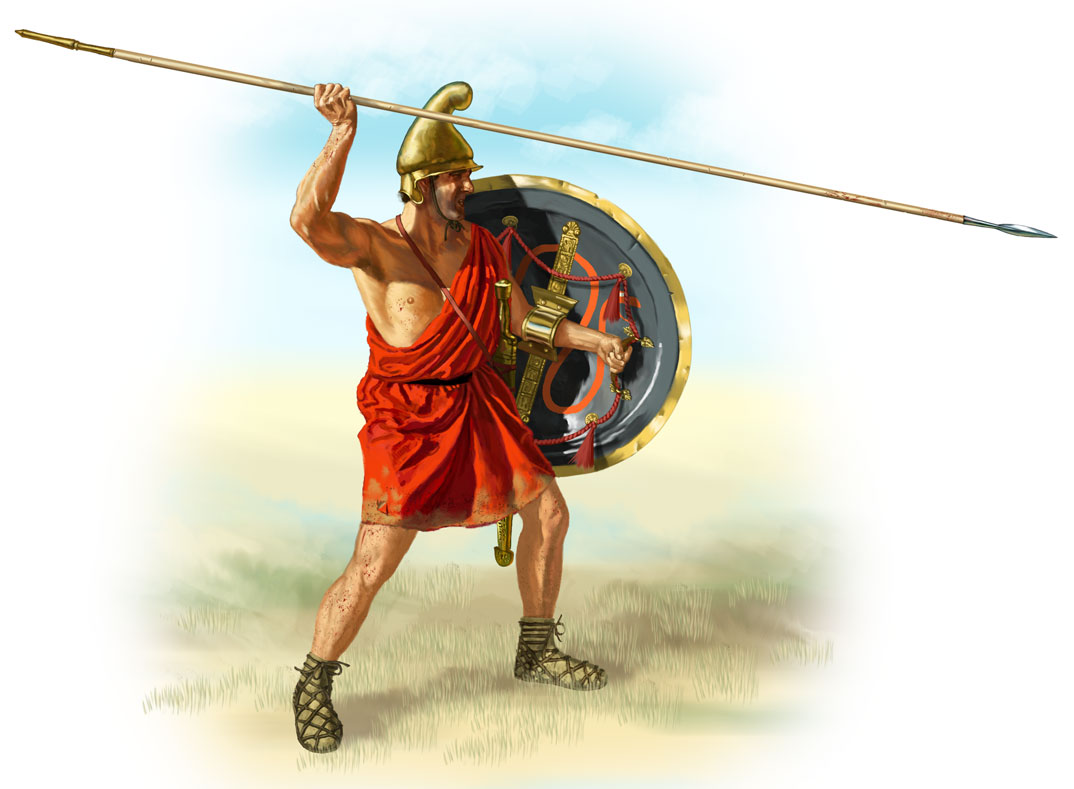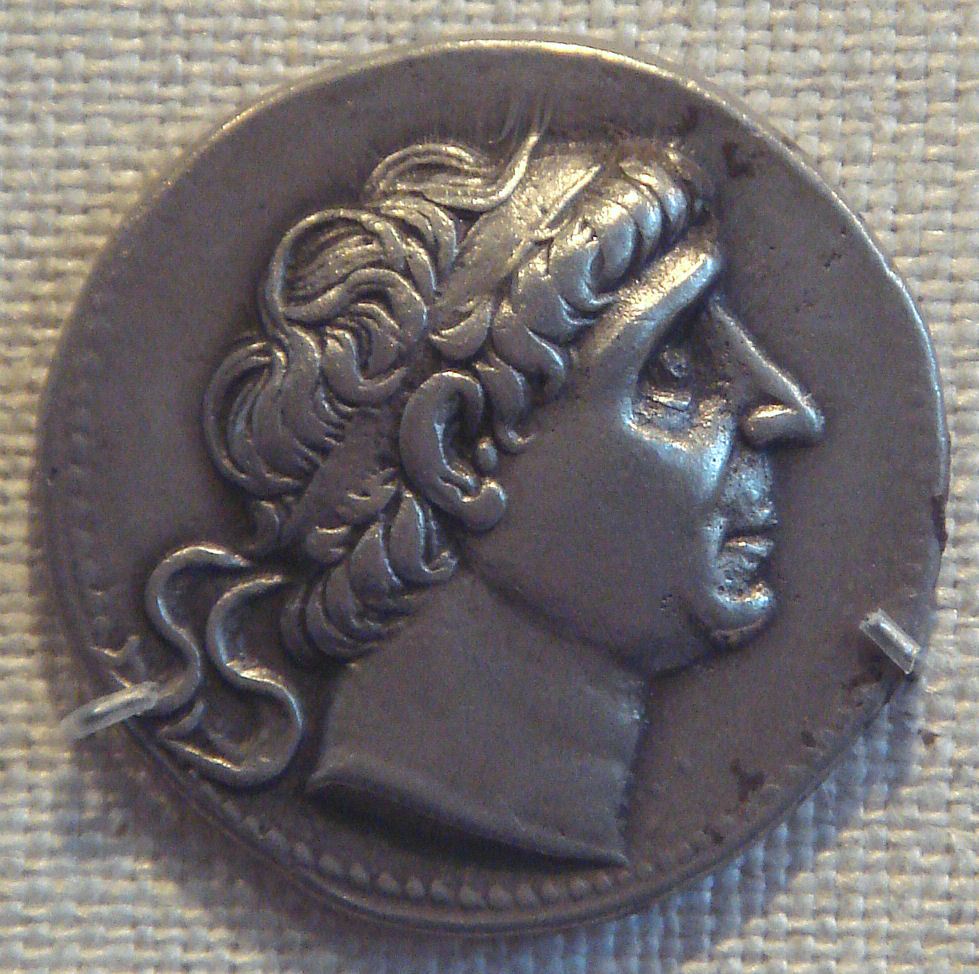|
Seleucus VI Epiphanes
Seleucus VI Epiphanes Nicator (; between 124 and 109 BC – 94 BC) was a Hellenistic Seleucid monarch who ruled Syria between 96 and 94 BC. He was the son of Antiochus VIII and his Ptolemaic Egyptian wife Tryphaena. Seleucus VI lived during a period of civil war between his father and his uncle Antiochus IX, which ended in 96 BC when Antiochus VIII was assassinated. Antiochus IX then occupied the capital Antioch while Seleucus VI established his power-base in western Cilicia and himself prepared for war. In 95 BC, Antiochus IX marched against his nephew, but lost the battle and was killed. Seleucus VI became the master of the capital but had to share Syria with his brother Demetrius III, based in Damascus, and his cousin, Antiochus IX's son Antiochus X. According to the ancient historian Appian, Seleucus VI was a violent ruler. He taxed his dominions extensively to support his wars, and resisted allowing the cities a measure of autonomy, as had been the practice of form ... [...More Info...] [...Related Items...] OR: [Wikipedia] [Google] [Baidu] |
Tetradrachm
The tetradrachm () was a large silver coin that originated in Ancient Greece. It was nominally equivalent to four drachmae. Over time the tetradrachm effectively became the standard coin of the Antiquity, spreading well beyond the borders of the Greek World. As a result, tetradrachms were minted in vast quantities by various polities in many weight and fineness standards, though the Athens-derived ''Attic standard'' of about 17.2 grams was the most common. Because of their large size, tetradrachms were often used by various states or rulers to advertise themselves or to deliver political messages. Popularity of the tetradrachm outlived the political independence of the Greeks and it remained in wide circulation in the Mediterranean up until Crisis of the Third Century, while debased varieties persisted in India and Central Asia into early Middle Ages. Due to their often high artistic level tetradrachms are eagerly collected in modern times, and well-preserved or rare specimen ... [...More Info...] [...Related Items...] OR: [Wikipedia] [Google] [Baidu] |
Tryphaena
Cleopatra Tryphaena (; c. 141 BC111 BC), well known simply as Tryphaena; was a Ptolemaic princess. She married the Seleucid king Antiochus VIII Grypus and was queen of Syria (124–111 BC). Biography Early life and Queen of Syria She was the oldest daughter of the Egyptian king Ptolemy VIII Physcon and his niece, step-daughter and wife Cleopatra III. Therefore, she was the sister of Ptolemy IX Lathyros, Ptolemy X Alexander I, Cleopatra IV and Cleopatra Selene. In 124 BC Ptolemy VIII broke with his former ally Alexander II Zabinas, instead supporting Antiochus VIII Grypus, the son of Demetrius II Nicator and Cleopatra Thea. As part of the new policy, Ptolemy VIII married his daughter Tryphaena to Antiochus VIII and also sent him reinforcements. The couple had five sons: Seleucus VI Epiphanes, the twins Antiochus XI Epiphanes and Philip I Philadelphus, Demetrius III Eucaerus, and Antiochus XII Dionysus. Their one daughter, Laodice, married Mithridates I Callinicus. Porphyry, q ... [...More Info...] [...Related Items...] OR: [Wikipedia] [Google] [Baidu] |
Ptolemaic Dynasty
The Ptolemaic dynasty (; , ''Ptolemaioi''), also known as the Lagid dynasty (, ''Lagidai''; after Ptolemy I's father, Lagus), was a Macedonian Greek royal house which ruled the Ptolemaic Kingdom in Ancient Egypt during the Hellenistic period. Reigning for 275 years, the Ptolemaic was the longest and last dynasty of ancient Egypt from 305 BC until its incorporation into the Roman Republic in 30 BC. Ptolemy, a general and one of the '' somatophylakes'' (bodyguard companions) of Alexander the Great, was appointed satrap of Egypt after Alexander's death in 323 BC. In 305 BC he declared himself Pharaoh Ptolemy I, later known as ''Sōter'' "Saviour". The Egyptians soon accepted the Ptolemies as the successors to the pharaohs of independent Egypt. The new dynasty showed respect to local traditions and adopted the Egyptian titles and iconography, while also preserving their own Greek language and culture. The Ptolemaic period was marked by the intense interactions and blending ... [...More Info...] [...Related Items...] OR: [Wikipedia] [Google] [Baidu] |
Antiochus VIII Grypus
Antiochus VIII Epiphanes/Callinicus/Philometor, nicknamed Grypus (, "hook-nose"), was the ruler of the Hellenistic Seleucid Empire from 125 to 96 BC. He was the younger son of Demetrius II and Cleopatra Thea. He may have spent his early life in Athens and returned to Syria after the deaths of his father and brother Seleucus V. At first he was joint ruler with his mother. Fearing her influence, Antiochus VIII had Cleopatra Thea poisoned in 121 BC. Political instability affected most of Antiochus VIII's reign. From 116 BC he fought a civil war against his half-brother Antiochus IX. Antiochus VIII's wife, the Ptolemaic Egyptian princess Tryphaena, had her sister and the wife of Antiochus IX, the former Cleopatra IV of Egypt, murdered in 112 BC; Antiochus IX killed Tryphaena in revenge. In 102 BC, Antiochus VIII's aunt Cleopatra III of Egypt, the mother of the two rival queens, gave him the hand of her daughter Cleopatra Selene in marriage. Antiochus VIII was assassinated in ... [...More Info...] [...Related Items...] OR: [Wikipedia] [Google] [Baidu] |
Frank Adcock
Sir Frank Ezra Adcock, (15 April 1886 – 22 February 1968) was a British classical historian who was Professor of Ancient History at the University of Cambridge between 1925 and 1951. In addition to his academic work, he also served as a cryptographer in both World War I and World War II. Early life and education Adcock was born in Desford, Leicester, Leicestershire, on 15 April 1886. He was the son of Thomas Draper Adcock, the head of Desford Industrial School, and Mary Esther Adcock (née Coltman). He was educated at Wyggeston Grammar School, a grammar school in Leicester. He went on to study classics at King's College, Cambridge. Career Academic career In 1911, Adcock was elected as a fellow and lecturer of King's College, Cambridge. He held the chair of Ancient History at the University of Cambridge from 1925 to 1951 when he retired. With J. B. Bury and S. A. Cook he edited ''The Cambridge Ancient History'', which was published from 1923 to 1939, and also wrote te ... [...More Info...] [...Related Items...] OR: [Wikipedia] [Google] [Baidu] |
Radoslav Katičić
Radoslav Katičić (; 3 July 1930 – 10 August 2019) was a Croatian and Yugoslav linguist, classical philologist, Indo-Europeanist, Slavist and Indologist, one of the most prominent Croatian scholars in the humanities. Biography Radoslav Katičić was born on 3 July 1930 in Zagreb which was part of Kingdom of Yugoslavia at the time. In 1949, he graduated at thclassical gymnasiumin his home town. At the Faculty of Humanities and Social Sciences, University of Zagreb, he received a degree in Classical Philology in 1954. The same year he started working as a part-time librarian at the Seminar for Classical Philology at the same faculty. His first scientific works were on Ancient Greek philology and Byzantine studies. As a stipendist of the Greek government, he visited Athens in 1956-57, and in 1958 he was elected as an assistant at the Department for Comparative Indo-European Grammar at the Faculty of Humanities and Social Sciences in Zagreb. In 1959, he received his Ph.D. w ... [...More Info...] [...Related Items...] OR: [Wikipedia] [Google] [Baidu] |
Ancient Macedonian Language
Ancient Macedonian was the language of the ancient Macedonians which was either a Ancient Greek dialects, dialect of Ancient Greek or a separate Hellenic languages, Hellenic language. It was spoken in the kingdom of Macedonia (ancient kingdom), Macedonia during the 1st millennium BC and belonged to the Indo-European languages, Indo-European language family. It gradually fell out of use during the 4th century BC, marginalized by the use of Attic Greek by the Macedonian aristocracy, the Ancient Greek dialect that became the basis of Koine Greek, the ''lingua franca'' of the Hellenistic period. It became Extinct language, extinct during either the Hellenistic or Roman imperial period (chronology), Roman imperial period, and was entirely replaced by Koine Greek. While the bulk of surviving public and private inscriptions found in ancient Macedonia were written in Attic Greek (and later in Koine Greek), fragmentary documentation of a vernacular local variety comes from Onomastics, on ... [...More Info...] [...Related Items...] OR: [Wikipedia] [Google] [Baidu] |
Seleucus I Nicator
Seleucus I Nicator (; Ancient Greek, Greek: Σέλευκος Νικάτωρ, ''Séleukos Nikátōr'', "Seleucus the Victorious"; ) was a Ancient Macedonians, Macedonian Greek general, officer and successor of Alexander the Great who went on to found the eponymous Seleucid Empire, led by the Seleucid dynasty. Initially a secondary player in the power struggles following Alexander's death, Seleucus rose to become the total ruler of Asia Minor, Syria (region), Syria, Mesopotamia, and the Iranian plateau, assuming the title of ''basileus'' (king). The Seleucid Empire was one of the major powers of the Hellenistic period, Hellenistic world, until it was overcome by the Roman Republic and Parthian Empire in the late second and early first centuries BC. While serving under Alexander, Seleucus was commander of the ''Hypaspists, Hypaspistai,'' an elite Macedonian infantry unit. After the death of Alexander in June 323 BC, Seleucus initially supported Perdiccas, the regent of Alexander's em ... [...More Info...] [...Related Items...] OR: [Wikipedia] [Google] [Baidu] |
List Of Seleucid Rulers
The Seleucid dynasty or the Seleucidae (; , ', "descendants of Seleucus") was a Macedonian Greek royal family, which ruled the Seleucid Empire based in West Asia during the Hellenistic period. It was founded by Seleucus I Nicator, a general and successor of Alexander the Great, after the division of the Macedonian Empire as a result of the Wars of the Successors ('' Diadochi''). Through its history, the Seleucid dominion included large parts of the Near East, as well as of the Asian territory of the earlier Achaemenid Persian Empire. A major center of Hellenistic culture, it attracted a large number of immigrants from Greece who, encouraged by the Seleucids, formed a dominant political elite under the ruling dynasty. After the death of Seleucus I, his successors maintained the empire's strength establishing it as a Greek power in West Asia; the empire reached its height under emperor Antiochus III. From the mid-second century BC, after its defeat at the hands of the re ... [...More Info...] [...Related Items...] OR: [Wikipedia] [Google] [Baidu] |
Appian
Appian of Alexandria (; ; ; ) was a Greek historian with Roman citizenship who prospered during the reigns of the Roman Emperors Trajan, Hadrian, and Antoninus Pius. He was born c. 95 in Alexandria. After holding the senior offices in the province of Aegyptus (Egypt), he went to Rome c. 120, where he practiced as an advocate, pleading cases before the emperors (probably as ''advocatus fisci'', an important official of the imperial treasury). It was in 147 at the earliest that he was appointed to the office of procurator, probably in Egypt, on the recommendation of his friend Marcus Cornelius Fronto, an influential rhetorician and advocate. Because the position of procurator was open only to members of the equestrian order (the "knightly" class), his possession of this office tells us about Appian's family background. His principal surviving work (Ρωμαϊκά ''Romaiká'', known in Latin as ''Historia Romana'' and in English as ''Roman History'') was written in Greek i ... [...More Info...] [...Related Items...] OR: [Wikipedia] [Google] [Baidu] |
Damascus
Damascus ( , ; ) is the capital and List of largest cities in the Levant region by population, largest city of Syria. It is the oldest capital in the world and, according to some, the fourth Holiest sites in Islam, holiest city in Islam. Known colloquially in Syria as () and dubbed, poetically, the "City of Jasmine" ( ), Damascus is a major cultural center of the Levant and the Arab world. Situated in southwestern Syria, Damascus is the center of a large metropolitan area. Nestled among the eastern foothills of the Anti-Lebanon mountain range inland from the eastern shore of the Mediterranean on a plateau above sea level, Damascus experiences an arid climate because of the rain shadow effect. The Barada, Barada River flows through Damascus. Damascus is one of the List of oldest continuously inhabited cities, oldest continuously inhabited cities in the world. First settled in the 3rd millennium BC, it was chosen as the capital of the Umayyad Caliphate from 661 to 750. Afte ... [...More Info...] [...Related Items...] OR: [Wikipedia] [Google] [Baidu] |





